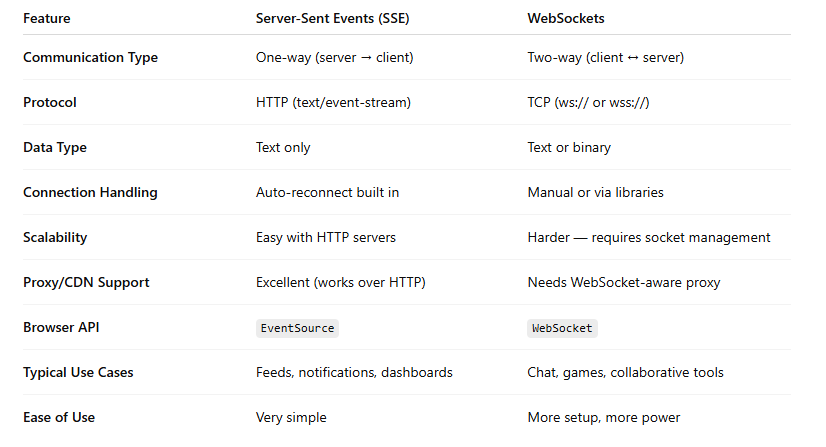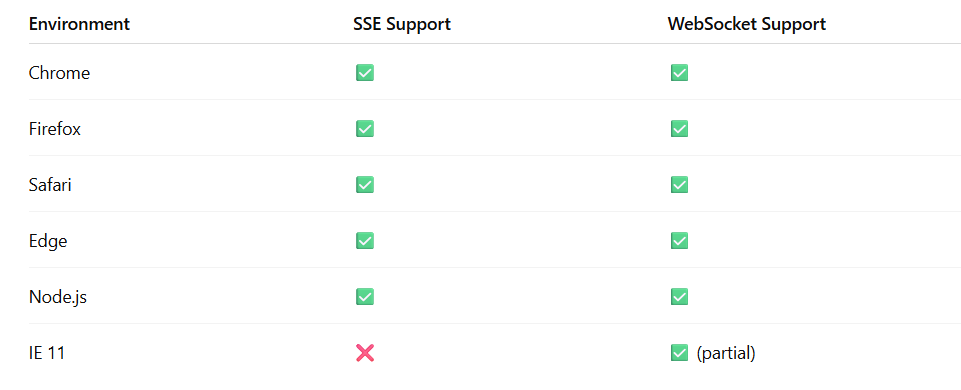Learn how Server-Sent Events and WebSockets work, their key differences, and how to pick the right one for your real-time web app.

Introduction
Modern users expect real-time experiences, think live chats, notifications, stock tickers, or collaborative editors.
As JavaScript developers, we have two main tools to make that happen:
- Server-Sent Events (SSE)
- WebSockets
Both let you send data from the server to the client without reloading or polling, but they work very differently.
In this article, you’ll learn:
- What real-time communication means in the browser
- How SSE and WebSockets actually work
- When to use each
- Practical code examples for both
By the end, you’ll know how to build a real-time feature using pure JavaScript, no heavy frameworks or plugins needed.
1. Why Real-Time Communication Matters
Traditional HTTP is request-response-based.
The client sends a request, the server responds once, and that’s it.
But what if you want:
- A chat app that updates instantly?
- A dashboard that reflects changes in real time?
- A notification system that alerts users immediately?
You need a way for the server to push data to the browser the moment something changes, not when the client asks.
That’s where Server-Sent Events and WebSockets come in.
2. Server-Sent Events (SSE): One-Way, Simple, Reliable
How It Works
Server-Sent Events (SSE) let the server push updates to the browser over a single, long-lived HTTP connection.
The browser opens a connection, and the server continuously sends updates whenever there’s new data.
It’s unidirectional data that only flows from the server to → client.
Client-Side Example
// Client
const eventSource = new EventSource('/events');
eventSource.onmessage = (event) => {
console.log('New message:', event.data);
};
Server-Side Example (Node.js + Express)
// Server
import express from 'express';
const app = express();
app.get('/events', (req, res) => {
res.setHeader('Content-Type', 'text/event-stream');
res.setHeader('Cache-Control', 'no-cache');
res.setHeader('Connection', 'keep-alive');
setInterval(() => {
res.write(`data: ${new Date().toISOString()}\n\n`);
}, 2000);
});
app.listen(3000, () => console.log('SSE running on port 3000'));
✅ The connection stays open.
✅ The server sends messages in plain text.
✅ The browser automatically reconnects if the connection drops.
It’s perfect for dashboards, notifications, or feeds that don’t need two-way interaction.
Under the Hood
- Uses standard HTTP (port 80 or 443)
- Content-Type:
text/event-stream - Messages are text-only and formatted as
data: <message>\n\n - Built-in reconnect in case of disconnects
- Lightweight and browser-native (
EventSourceAPI)
3. WebSockets: Two-Way, Fast, Interactive
How It Works
WebSockets create a full-duplex (two-way) communication channel over a single TCP connection.
Once established, both the server and client can send and receive messages anytime.
Think of it as a direct pipe between the two no request-response pattern at all.
Client-Side Example
const socket = new WebSocket('ws://localhost:3000');
socket.onopen = () => console.log('Connected');
socket.onmessage = (event) => console.log('Server says:', event.data);
// Send data to server
socket.send('Hello Server!');
Server-Side Example (Node.js + ws)
import { WebSocketServer } from 'ws';
const wss = new WebSocketServer({ port: 3000 });
wss.on('connection', (socket) => {
console.log('Client connected');
socket.on('message', (msg) => console.log('Received:', msg));
setInterval(() => {
socket.send(`Server time: ${new Date().toLocaleTimeString()}`);
}, 2000);
});
✅ Both sides can send data freely.
✅ Works great for chat apps, collaboration tools, and live games.
✅ Can send binary data, not just text.
4. SSE vs WebSockets — Head-to-Head Comparison

Summary:
- Use SSE when you only need server → client streaming.
- Use WebSockets when both sides need to talk to each other.
5. When to Use Server-Sent Events
Best For
- News or activity feeds
- System monitoring dashboards
- Real-time logs or build progress
- Live scores, updates, notifications
Why
- Simple HTTP connection
- Built-in auto-reconnect
- Works with CDNs and load balancers
- Uses minimal server resources
Example: Live Stock Ticker
const source = new EventSource('/stocks');
source.onmessage = (e) => {
updateStockList(JSON.parse(e.data));
};
Perfect for sending frequent updates from the server without needing a two-way connection.
6. When to Use WebSockets
Best For
- Chat applications
- Multiplayer games
- Real-time collaboration (e.g., document editing)
- Live trading systems
- IoT devices sending telemetry data
Why
- Full-duplex: both sides communicate freely
- Ultra-low latency
- Can handle thousands of simultaneous connections
Example: Live Chat
const ws = new WebSocket('wss://example.com/chat');
ws.onmessage = (e) => addMessage(e.data);
document.querySelector('form').onsubmit = (e) => {
e.preventDefault();
ws.send(messageInput.value);
};
Messages are sent instantly in both directions, no reloading, no lag.
7. Handling Reconnection and Errors
In SSE: Easy
The browser automatically reconnects after a few seconds if the connection drops.
eventSource.onerror = () => console.log('Connection lost, reconnecting...');
In WebSockets: Manual
You need to handle reconnection logic yourself.
socket.onclose = () => {
setTimeout(() => {
socket = new WebSocket('ws://localhost:3000');
}, 3000);
};
Libraries like Socket.IO simplify this by adding auto-reconnect and event handling on top of WebSockets.
8. Scalability and Performance

For large-scale systems (like multiplayer games), WebSockets win.
For lightweight, broadcast-style updates, SSE is simpler and more scalable.
9. Browser and Server Support

Both are well-supported in modern browsers, but SSE doesn’t work in old Internet Explorer versions.
10. Choosing Between SSE and WebSockets
If you’re unsure which to pick, use this quick guide:

In short:
- Start with SSE for simplicity.
- Switch to WebSockets when you need full-duplex power.
Conclusion
Both Server-Sent Events and WebSockets bring real-time magic to JavaScript apps.
They solve the same problem, keeping your users updated live, but they take different approaches.
- SSE is simple, reliable, and HTTP-friendly, ideal for feeds and dashboards.
- WebSockets are powerful, flexible, and built for full-duplex interactivity.
If your web app needs a lightweight stream of updates, use SSE.
If it’s more interactive and chat-like, go for WebSockets.
Pro Tip: You can even combine both SSE for broadcasting events and WebSockets for direct messaging.
Call to Action
Which approach are you using for real-time communication: SSE, WebSockets, or both?
Share your experience in the comments and bookmark this guide for your next real-time JavaScript project.


Leave a Reply